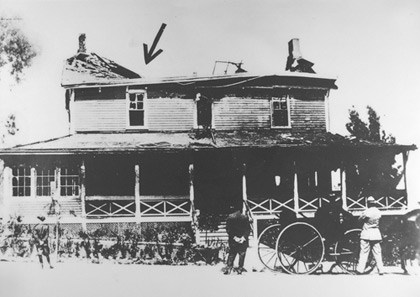
Library of Congress The foremost military leader of his time, General John "Black Jack" Pershing (1860-1948) served in the Indian Wars, the Spanish-American War, the Philippines, the Mexican Intervention and World War I. During his next assignment in Washington, Captain Pershing met Helen Frances Warren, a recent graduate of Wellesley College and daughter of United States Senator Francis E. Warren of Wyoming. Though twenty years her senior, Pershing charmed Miss Warren. In describing a social gathering, she wrote, "Danced every dance but one, and have lost my heart to Captain Pershing irretrievably." The courtship lasted a year, sustained by traditional wooing and love letters. The two were married in a wedding attended by President Theodore Roosevelt just days before Pershing shipped out to Tokyo, Japan, where he served as a military attaché and observer of the Russo-Japanese War. Captain Pershing's brilliance continued to be recognized. In 1906, he was promoted to Brigadier General, skipping over 862 senior officers. After Japan, Brigadier General Pershing was sent back to the Philippines to command Fort McKinley. During this time, Pershing once again worked with the Moros in their development of a constitution and organization of a local government. In 1913, Pershing successfully led troops to overtake outlaw Moros in the Mount Bagsak campaign, for which he was awarded the Distinguished Service Medal. On January 13, 1914, General Pershing took command of the 8th Infantry Brigade at the Presidio of San Francisco. It wasn't long, however, before tensions along the Mexican border forced the 8th Infantry to be transferred to Fort Bliss, Texas. While her husband was away, Mrs. Pershing and the four children remained at the family's two-story Victorian house at the Presidio. Tragedy struck on Friday, August 27, 1915, when hot coals spilled from the hearth of the Pershing home and onto the highly waxed floor. The house was quickly consumed by flames; Frances and her three daughters—aged eight, seven, and three—perished in the blaze. Only five year-old Warren survived after being rescued by Pershing's long-time black orderly. Visiting the site, Pershing could only comment, "They had no chance." 
National Park Service, GGNRA After the funeral, General Pershing returned to Texas. Filled with grief, he turned all of his attention to his work. Around this time, the Mexican bandit Francisco “Pancho” Villa was leading raids along the border. In March 1916, Villa led a cavalry raid on Columbus, New Mexico, that left soldiers and civilians dead. In response, President Woodrow Wilson ordered the Army to pursue Villa in Mexico. General Pershing organized 10,000 men for the expedition—including his old 10th Cavalry Buffalo Soldiers. Pershing led several expeditions deep into Mexico. Though Villa was never caught, talks with Mexican President Venustiano Carranza resulted in an agreement to deter outlaws like Villa from entering the United States. Learn more about the General: |
Last updated: February 28, 2015
